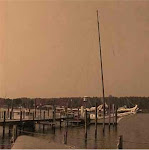 June, 2010
June, 2010It started out as simply a good idea to replace the dredge chocks, as long as first class shipwrights were on-site and something as extreme as a keel was being replaced. And of course railing. It is always a good idea to update railing. That led to some decking. Then some more decking. Then the decking around the fore cabin. Then the hull.
By the time the U.S. Coast Guard arrived last week for inspection and endorsement there were holes in the skipjack where a captain never wants to see holes.
But it started so simply, with the chocks:
And that led to this:

Among the volunteers working to keep the vessel readied for the next day's shipwrights are Dave Cronce of Bainbridge, Pa. and Matthew Clements of Roanoke, Va. Both men are from the Harry Lundeberg School of Seamanship at the Paul Hall Center of the Seafarer's International Union -- a generous and long-term supporter of the Chesapeake Bay Field Lab, Inc., the 501(c)3 that owns and operates the Dee of St. Mary's.
Visit www.thebaylab.org to learn more about educational programing and tours.




No comments:
Post a Comment